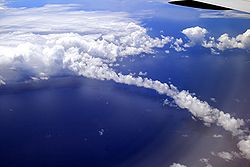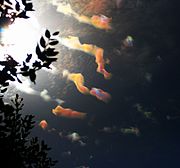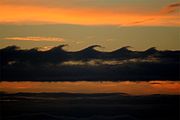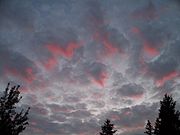
Cloud
Did you know...
SOS Children made this Wikipedia selection alongside other schools resources. Before you decide about sponsoring a child, why not learn about different sponsorship charities first?
A cloud is a visible mass of droplets or frozen crystals floating in the atmosphere above the surface of the Earth or another planetary body. A cloud is also a visible mass attracted by gravity (clouds can also occur as masses of material in interstellar space, where they are called interstellar clouds and nebulae.) The branch of meteorology in which clouds are studied is nephology.
On Earth the condensing substance is typically water vapor, which forms small droplets or ice crystals, typically 0.01 mm in diameter. When surrounded by billions of other droplets or crystals they become visible as clouds. Dense deep clouds exhibit a high reflectance (70% to 95%) throughout the visible range of wavelengths: they thus appear white, at least from the top. Cloud droplets tend to scatter light efficiently, so that the intensity of the solar radiation decreases with depth into the gases, hence the gray or even sometimes dark appearance of the clouds at their base. Thin clouds may appear to have acquired the colour of their environment or background, and clouds illuminated by non-white light, such as during sunrise or sunset, may be colored accordingly. In the near-infrared range, clouds would appear darker because the water that constitutes the cloud droplets strongly absorbs solar radiation at those wavelengths.

Clouds are divided into two general categories: layered and convective. These are named stratus clouds (or stratiform, the Latin stratus means "layer") and cumulus clouds (or cumuliform; cumulus means "piled up"). These two cloud types are divided into four more groups that distinguish the cloud's altitude. Clouds are classified by the cloud base height, not the cloud top. This system was proposed by Luke Howard in 1802 in a presentation to the Askesian Society.
High clouds (Family A)
These generally form above 20,000 feet (6,000 m), in the cold region of the troposphere. In Polar regions, they may form as low as 16,500 ft (5,030 m); they are denoted by the prefix cirro- or cirrus. At this altitude, water frequently freezes so clouds are composed of ice crystals. The clouds tend to be wispy and are often transparent.
Clouds in Family A include:
- Cirrocumulus (Cc)
- Cirrostratus (Cs)
- Cirrus (Ci)
- Cirrus Kelvin-Helmholtz Colombia
- Cirrus uncinus
- Contrail, a long thin cloud which develops as the result of the passage of an aircraft at high altitudes.
- Pileus
Middle clouds (Family B)
These develop between 6,500 and 20,000 feet (between 2,000 and 6,000 m) and are denoted by the prefix alto-. They are made of water droplets and are frequently supercooled.
Clouds in Family B include:
- Altocumulus (Ac)
- Altocumulus castellanus
- Altocumulus lenticularis
- Altocumulus mackerel sky
- Altocumulus undulatus
- Altostratus (As)
- Altostratus undulatus
Low clouds (Family C)
These are found up to 6,500 feet (2,000 m) and include the stratus (dense and grey). When stratus clouds contact the ground, they are called fog.
Clouds in Family C include:
- Cumulus humilis (Cu)
- Cumulus mediocris (Cu)
- Nimbostratus (Ns)
- Stratocumulus (Sc)
- Stratus (St)

Vertical clouds (Family D)
These clouds can have strong up-currents, rise far above their bases and form at many heights.
Clouds in Family D include:
- Cumulonimbus (associated with heavy precipitation and thunderstorms) (Cb)
- Cumulonimbus calvus
- Cumulonimbus incus
- Cumulonimbus with mammatus
- Cumulus congestus
- Pyrocumulus
Other clouds
A few clouds can be found above the troposphere; these include noctilucent and polar stratospheric clouds (or nacreous clouds), which occur in the mesosphere and stratosphere respectively.
Some clouds form as a consequence of interactions with specific geographical features. Perhaps the strangest geographically-specific cloud in the world is Morning Glory, a rolling cylindrical cloud which appears unpredictably over the Gulf of Carpentaria in Northern Australia. Associated with a powerful "ripple" in the atmosphere, the cloud may be "surfed" in unpowered glider aircraft.
Cloud fields
A cloud field is simply a group of clouds but sometimes cloud fields can take on certain shapes that have their own characteristics and are specially classified. Stratocumulus clouds can often be found in the following forms:
- Actinoform, which resembles a leaf or a spoked wheel.
- Closed cell, which is cloudy in the centre and clear on the edges, similar to a filled honeycomb.
- Open cell, which resembles a honeycomb, with clouds around the edges and clear, open space in the middle.
Colors
The colour of a cloud tells much about what is going on inside the cloud. Clouds form when relatively warm air containing water vapor is lighter than its surrounding air and this causes it to rise. As it rises it cools and the vapor condenses out of the air as micro-droplets. These tiny particles of water are relatively densely packed and sunlight cannot penetrate far into the cloud before it is reflected out, giving a cloud its characteristic white colour. As a cloud matures, the droplets may combine to produce larger droplets, which may combine to form droplets large enough to fall as rain. In this process of accumulation, the space between droplets becomes larger and larger, permitting light to penetrate much farther into the cloud. If the cloud is sufficiently large and the droplets within are spaced far enough apart, it may be that a percentage of the light which enters the cloud is not reflected back out before it is absorbed (Think of how much farther one can see in a heavy rain as opposed to how far one can see in a heavy fog). This process of reflection/ absorption is what leads to the range of cloud colour from white through grey through black. For the same reason, the undersides of large clouds and heavy overcasts appear various degrees of grey; little light is being reflected or transmitted back to the observer.
Other colours occur naturally in clouds. Bluish-grey is the result of light scattering within the cloud. In the visible spectrum, blue and green are at the short end of light's visible wavelengths, while red and yellow are at the long end. The short rays are more easily scattered by water droplets, and the long rays are more likely to be absorbed. The bluish colour is evidence that such scattering is being produced by rain-sized droplets in the cloud.
A greenish tinge to a cloud is produced when sunlight is scattered by ice. A cumulonimbus cloud which shows green is an imminent sign of heavy rain, hail, strong winds and possible tornadoes.
Yellowish clouds are rare but may occur in the late spring through early fall months during forest fire season. The yellow colour is due to the presence of smoke.
Red, orange and pink clouds occur almost entirely at sunrise/sunset and are the result of the scattering of sunlight by the atmosphere. The clouds are not that colour; they are reflecting the long (and unscattered) rays of sunlight which are predominant at those hours. The effect is much the same as if one were to shine a red spotlight on a white sheet. In combination with large, mature thunderheads this can produce blood-red clouds.
Clouds on other planets
Within our solar system, any planet or moon with an atmosphere also has clouds. Venus' clouds are composed entirely of sulfuric acid droplets. Mars has high, thin clouds of water ice. Both Jupiter and Saturn have an outer cloud deck composed of ammonia clouds, an intermediate deck of ammonium hydrosulfide clouds and an inner deck of water clouds. Uranus and Neptune have atmospheres dominated by methane clouds.
Saturn's moon Titan has clouds which are believed to be composed largely of droplets of liquid methane. The Cassini-Huygens Saturn mission has uncovered evidence of a fluid cycle on Titan, including lakes near the poles and fluvial channels on the surface of the moon.









